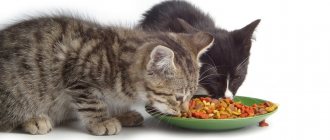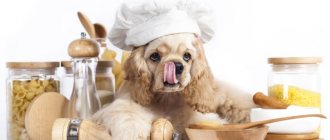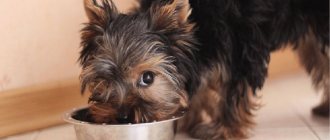At two months, the kitten is weaned from its mother, and less often, it is weaned from breastfeeding. But in any case, it is transferred to the “adult” menu.
This is no longer feeding, like for one-month-old babies, but a complete diet. The more balanced and nutritious it is, the healthier the puppy will grow up.
During this period, it is important to properly plan your diet. If the dog is the first, it is easy to make mistakes that will affect the body. We will consider in detail the issue of feeding two-month-old puppies, as well as the nutritional features of large, medium-sized and decorative breeds.
Basic feeding rules
Two months is the most difficult age for puppies. They experience stress after stress: moving to a new home, first vet visits and vaccinations, meeting new people, places and animals. In addition, two-month-old kittens grow rapidly: from 8 to 12 weeks their weight doubles.
Let's look at the basic rules that should be taken into account when feeding puppies.
For the first 2 weeks after purchasing the baby, he is fed the same food as the breeder
. Only in the 3rd week do they change the diet, introducing new products and gradually increasing their volume. If you immediately transfer the puppy to a new menu, disruption of the gastrointestinal tract is guaranteed.
The approximate diet for two-month-old kittens consists of: 40-45% meat, 35-40% dairy and fermented milk products, 15-30% vegetables, cereals and other foods
. But these proportions are approximate and depend on the breed (naturally, the needs of a Yorkie and a Shepherd are different), size, gender and individual development of the dog.
Meat is the main component.
It is given at the rate of 15-30 g per 1 kg of weight per day. However, the calculations are again approximate and depend on individual factors.
For example, bulldogs feel great on a low-protein diet, while huskies have only 25 g of meat. Here they focus on the characteristics of the breed and the well-being of the baby.
Food temperature – room temperature or slightly higher
. Hot and cold foods irritate the esophagus and stomach.
An important question is how many times a day should you feed a two-month-old puppy?
Food should be given 5-6 times a day at regular intervals.
By the 3-4th month, reduce the number of meals to four. Avoid night feedings after 10-11 pm - the baby’s stomach should rest.
Feeding should be done every day at a certain time
to develop a diet.
Provide constant access to water.
It is recommended to change the water 2-4 times a day, because... When drinking, food debris, saliva, fur, and dirt get into the liquid.
It is advisable to use bowls with a stand.
Their height is adjustable so that the pet keeps its neck straight without stretching it up or down. Otherwise, a high load is created on the shoulder girdle, which over time can lead to deformation of the skeleton.
Remember that it is at 2 months that the puppy develops eating habits and the concept of a routine. Instill a love for quality nutrition by the hour and you will get a healthy, hardy dog.
What to feed 2-month-old puppies of small, medium and large breeds: natural food
If the natural type of feeding is taken as the basis, then the basic principles of creating a diet for puppies of two months of age will be as follows:
- All products must be fresh and food must be prepared for one day.
- The food is salted, but by the standards of human nutrition it remains unsalted.
- At least a third of the diet consists of lean meat.
- Cereals are taken with a low glycemic index.
- Vegetables are required in the diet, as are fermented milk products.
- A required ingredient is fat and oil.
- Don't forget about vitamin supplements.
- Water is an integral component of the diet.
What is better for a puppy: natural food or ready-made food?
There are 2 types of dog food - natural and ready-made food (dried, canned). Which diet is better - there is no clear answer.
Some owners or breeders believe that it is impossible to balance a puppy’s diet on a natural menu: in order to calculate the calories, vitamins, minerals consumed by the dog and their expenditure, a laboratory is needed. Others believe that industrial feeds are divorced from natural nutrition and you cannot be sure of the quality of the products.
It is worth considering that:
- “Naturalka” takes time to purchase products, prepare and create a menu. This option is unlikely to be suitable for busy owners.
- It is not recommended to mix natural and prepared diets even at different meals.
- Ready-made meals will save time, but will cost significantly more. After all, you will have to buy high-quality food for your puppy. Feeding “economy class” food to children is not acceptable.
If dry food, what kind?
If you prefer ready-made food, buy holistic or super-premium grain-free brands. They are the best.
Advice - forget about advertised companies like Pedigree, Chappi. Focus on the composition and reviews of breeders and veterinarians.
The best food for small breeds
(Yorkshire Terrier, Pomeranian Spitz, Chihuahua, Miniature Poodle, etc.):
- Applaws with chicken for small and medium breeds;
- Acana Heritage for small puppies;
- Guabi Natural for miniature puppies;
- 1st Choice for decorative and small breeds.
Recommended food lines for large and medium breed
(spaniel, labrador, alabai, etc.):
- Orijen for large puppies;
- Applaws for large breed puppies;
- Acana Heritage for large puppies;
- Savarra for large breed meat with lamb and rice.
Suitable for everyone, from a toy terrier to a Tibetan mastiff:
- Orijen grain-free for puppies;
- Grandorf hypoallergenic with lamb and rice for puppies of all breeds - it is recommended for breeds with a tendency to food allergies: pugs, French bulldogs, Shar Peis, Pekingese;
- Optima Nova Sensitive with salmon and potatoes for all puppies;
- Genesis Pure Canada Green Highland Puppy;
- Carnilove salmon and turkey puppies;
- Pronature Holistic for chicken and potatoes;
- Barking Heads Puppy Days with salmon and trout.
Opinions are also divided on whether it is worth soaking the food. The two-month-old puppy no longer has problems chewing and digesting food. The only thing is that he can refuse “crackers”, because... they look and smell unusual. In this case, add a little warm water to the dryer before feeding.
Feeding puppies dry food
Dry food is usually pre-selected by the breeder who sells the puppies. He recommends a proven brand that was given to the puppy before sale. They start feeding dry foods only from 2.5-3 months, choosing super-premium food for small puppies . Their specificity is hypoallergenicity and small granules. It is recommended to further soften the granules with water.
How much to give a puppy this or that food is indicated in the instructions on the package.
How to determine the correct serving size?
New owners of two-month-old puppies often go from one extreme to another: either it seems to them that they are overfeeding the baby, or they think that they are underfeeding.
Both overeating and undereating are bad. But for the health of the heart and joints, it is better to slightly (just slightly!) underfeed your dog. This advice is especially useful for large breeds (such as German and Caucasian Shepherds, Alabai, VEO), whose bones and ligaments are already under heavy stress.
The amount of daily food should be approximately 5-7% of the dog’s weight or 260-270 kcal per 1 kg. But this is an average rule.
You can more accurately determine what portions to give your puppy at 2 months.
Place a bowl of food. Normally, the baby eats food in 10-15 minutes and licks the bowl a couple of times. If after 15-20 minutes there are food left, you are overfeeding the dog. If your pet swallows a portion in 2-5 minutes and licks the dishes for a long time, you are underfeeding.
There is another option. Give the puppy a known large portion. Keep an eye on the dog: as soon as the last (false) ribs are visible, take the bowl away. This way you will slightly underfeed the dog. This method is used for hunting breeds of lean build - shorthaired pointer, drathaar, Russian hunting spaniel.
There is no such problem with ready-made food. The package indicates the exact daily drying volume based on the weight of a two-month puppy. The only thing is that the amount sometimes has to be adjusted if the baby has an accelerated or slow metabolism.
How to feed a puppy correctly?
Do you want to know what you can and what is the best way to treat your little furry so that he turns into a beautiful and healthy dog? Then we will try to delve deeper into this difficult issue. Experienced dog breeders do not consider this topic particularly problematic and feed the puppy “automatically,” so to speak. But someone who got a dog for the first time has a million questions about nutrition at the same time, and everything needs to be answered immediately, since a living creature will not wait.
It is very important not to overfeed the puppy, breaking his stomach to incredible sizes. Regular overeating has just as bad an effect on the animal's condition as undernutrition. Large breed dogs that quickly gain weight have a good chance of developing joint problems.
Next, you will learn what to feed your puppy, how to choose the right combination of foods for the menu, and also what foods should be kept away from the dog.
How to properly feed a puppy natural food?
The first thing a dog owner should understand is that his food should always be fresh. After all, for ourselves, don’t we buy meat a little cheaper and tastier? You should treat an animal with the same responsibility as you would treat your child. Poisoning from poor-quality food is a common occurrence in pets.
A dog at home is often fed natural products. It will cost a little less than dry food, and the owner can always be sure of the quality. But you should immediately prepare for the fact that now you will be faced with frequent and regular purchases, heavy bags and constant cooking, because at first the puppy eats very often. If this doesn’t scare you, let’s take a look at the list of products that the growing body of a dog of any breed requires.
Important!
Never give your puppy food from your table - such food is absolutely not suitable for him, even if it is aromatic borscht cooked with soul.
So, to feed a young dog we will need:
- Milk. A small puppy is fed milk for up to 4 months. It is vital for the pet for normal growth and development. Milk is given in its pure form or porridge is cooked with it. But here the question arises - what kind of milk should I feed? It is better if it is goat, since allergies to it are very rare. But it is not always possible to get it. Therefore, cow's milk is suitable, but not whole, but diluted, so as not to cause upset in the puppy. Closer to 6 months, the amount of milk is reduced, and then it is removed altogether, replacing it with sour milk.
- Dairy products. For good digestion, as well as to enrich the body with calcium, a young dog must be given cottage cheese, kefir, and low-fat sour cream. Not everyone knows that you can give your puppy a serum that contains a lot of useful substances, but it costs literally pennies. When the puppy grows up, the amount of fermented milk products will be much less - 2-3 times a week. Hard cheese is very useful for a puppy, which is given to him as a reward for success in training.
- Meat. It should be at least 40% in the diet or 20-30 grams per kilogram of weight. Meat is given raw, frozen, boiled or scalded. However, most of the time the puppy is fed raw meat, since the dog is, after all, a predator. It is allowed to feed the puppy skinless chicken, turkey, veal, beef, and horse meat. In addition to pure meat, meat by-products are very useful for a puppy. Like meat, they are given cooked or raw. It is very good to include a cow's stomach, udder, trachea, liver, and kidneys in the diet of a growing dog. All meat products should be cut into small cubes, but not in the form of minced meat.
- Fish. The puppy should be given fish or seafood twice a week. It can be squid, shrimp, mackerel, hake, pollock. If you are confident in the purity of the product, then boiling is not necessary. But it is better to refuse river fish. In addition to the high risk of infection with helminths, there is a chance that the puppy will choke on a bone, since they are very small and it is simply unrealistic to choose everything. Fish is given instead of meat feeding.
- Vegetables. Every baby needs vitamins. Most of them are found, of course, in vegetables. Gradually they are offered to the animal, mixed with cottage cheese or porridge. You can grate them on a fine grater and serve them fresh or stewed - this way they are better absorbed without causing upset. It is good to give the puppy pumpkin, carrots, zucchini, beets, and also add a little greens - onions, parsley, spinach.
- Berries and fruits. Many dogs love fruit. But not all owners know whether they can be allowed to eat them. You definitely can’t force a dog to eat something that is healthy if it doesn’t want to. But if your dog happily crunches an apple or picks up fallen apricots and at the same time everything is fine with his digestion, this vitamin supplement is very useful. It is undesirable to give your puppy grapes and currants, which cause bloating and accumulation of harmful substances in the body. You need to be careful with stone fruits, which contain hydrocyanic acid, as well as with bananas - they quickly make the puppy fat.
- Cereals. It is mandatory to feed the puppy porridge. But it serves only as an addition to the main milk and meat diet. Under no circumstances should your puppy eat only cereal. In the first months, baby porridge is cooked in milk. It could be semolina, rice, buckwheat, oatmeal. You need to watch how the dog tolerates this or that product. If buckwheat doesn’t work out and the dog gets upset from it, then this grain is excluded for a while.
Important! As an invaluable protein product, you can and should use egg yolks both in their pure form and in the form of an omelette twice a week, but it is better to give quail eggs.
How to properly feed a puppy dry food?
Feeding a growing dog natural food is cheaper, but the preparation process takes a lot of time. It is much easier to give your baby dry puppy food. It is properly balanced and there is no need for additional vitamins and minerals.
There are three classes of food:
- Economy;
- Premium;
- Super premium.
The last two are recommended for dogs whose owners really care about their health. Let's find out which brands of puppy food are the healthiest and most popular:
- Hill's
- Royal Canin
- Eagle Pack
- Purina Proplan
- Genesis
- Diamond
Important! If you don’t know what is best to feed your puppy, and you decide to switch your baby from natural food to dry food, then you need to do this gradually. The same applies to changing the brand of food.
Please note that it is better to give dry food to a puppy in a soaked form. To do this, half an hour before feeding, the crackers are poured with warm water to swell. You should never use broths for this - only clean water. The food packaging indicates the norms for each age. These should not be exceeded due to the risk of nutrient overdose. Owners should be aware that dry food is given less than natural food due to its high concentration and calorie content.
Important! For those who give their puppy dry food, there is good news - the number of bowel movements per day will be less than with natural food. So you will have to clean up less too.
Supplements to the basic diet
It’s hard to imagine a complete diet for a two-month-old puppy without fortified supplements and “snacks.” The main thing is to know which and how much you can give.
Vitamins and minerals
Mineral and vitamin supplements are not needed when feeding prepared foods. The dryer already contains all the necessary components. If additional drugs are administered, this will lead to hypervitaminosis.
But natural nutrition is difficult to balance. Therefore, vitamins and minerals are required.
There are 2 types of vitamin and mineral supplements:
- Industrial.
The best are considered to be 8 in 1 Excel Multi Vit, Canvit Junior, Beaphar for puppy, Biorhythm, Doctor Zoo.- Natural.
Brewer's yeast, feed sulfur, bone meal, calcined cottage cheese, fish oil.
Puppies of large breeds (for example, VEO, St. Bernard, Rottweiler, Alabai, Samoyed) are given calcium, phosphorus and magnesium for the proper formation of bones and joints.
And in winter, fish oil and vitamins A and D are recommended for 2-month-old kittens to prevent rickets.
Goodies and treats
Any dog is sure that a day without a treat will be in vain. To please your pet and not harm her, select healthy treats:
- Ready from stores.
Dried offal, dried meat without salt and seasoning, deer antlers, cookies, sinew bones. - Made at home.
Bread crumbs, oven-dried meat, hard unsalted cheese.
Giving a 2-month-old puppy unlimited amounts of treats is prohibited. This is just a way to please your baby, encourage good behavior, develop a necessary habit, or teach a command.
The maximum daily amount of treats is no more than 10% of the total diet.
Vitamins and mineral supplements in the diet
Dry food contains minerals and vitamins, but with a natural diet, the puppy will need additional microelements. There are special veterinary vitamin complexes in the form of tablets or dry powders that are mixed with food. One of the most popular is Nutri-Vet Puppy-Vite, intended for puppies under 9 months.
Natural supplements you can use:
- Crushed or granulated chalk;
- Eggshells (ground into powder);
- A teaspoon a day of fish oil;
- A teaspoon of honey per day in porridge (be careful, this product is a strong allergen, consultation with a specialist is required);
- Brewer's yeast;
- From 2-3 months they give beef trachea and cartilage.
Puppies of all breeds should receive vitamins A and D-2 daily in drops (depending on the size, a dose of 1-2 drops is prescribed); calcium tablets 1-3; phytin tablets 1-3.
Basic prohibitions
There are foods that are undesirable or strictly prohibited to be given to two-month-old puppies. Of course, the first thing that is dangerous is constant feeding of junk food. But even an accidentally eaten piece can cause serious consequences.
It would seem that a tiny piece of chocolate or sausage once a month will not affect the puppy’s health. But it's not that simple. The product may not harm, for example, a large husky. But for small Shih Tzus or Chihuahuas, a dose of dangerous ingredients in a piece will be fatal.
Strictly prohibited and “controversial” products
Absolutely harmful to all puppies:
- salty, spicy, smoked, fried, fatty foods;
- semi-finished products and fast foods;
- sausages, canned food, marinades;
- garlic, onion;
- citrus fruit;
- sweets (especially chocolate), confectionery and bakery products;
- grapes, raisins;
- tubular bones of poultry, fish, leather;
- mushrooms, nuts;
- alcoholic, carbonated, sweet drinks.
Some of these products lead to health problems if consumed regularly. Others immediately cause intoxication, allergies, and gastrointestinal disorders.
There are products that some owners consider undesirable, while others consider them harmless if consumed rarely. This:
- pork - raw meat is fatty, may contain helminths, but boiled meat can be fed occasionally;
- potatoes are pure starch when boiled, but you can treat them with 1-2 slices of raw root vegetables;
- tomatoes - a large amount can lead to poisoning, but in small doses they remove plaque from teeth;
- honey is an allergen, but at the same time a storehouse of useful substances;
- semolina and pearl barley are pure carbohydrates and cause bloating, but porridge with milk helps exhausted babies at 2 months to gain weight;
- peas, soybeans, beans, beans, corn: they cause gas formation and are difficult to digest, but if the dog loves them, a few grains will not harm.
Water in the diet
As long as the puppy feeds on its mother's milk, it is not at risk of dehydration. After weaning, this condition may occur within 1-2 hours . Therefore, in the first months, the animal must be mixed with diluted bitch milk extract during dry feeding. With natural feeding this is not required.
Without enough fluid, puppies' blood thickens, which leads to oxygen starvation and metabolic disorders. You can give additional water using a syringe without a needle or syringe.
A dog is not a trash container. She should not eat table scraps. A puppy, as a young and developing organism, must receive all the necessary microelements in the best quality products. Otherwise, his health will be threatened by viruses, infections and pathological diseases.
4.4 / 5 ( 11 votes)
Features of the diet of two-month-old puppies of different breeds
The nutrition of two-month-old puppies of different breeds is different. And this is natural. For example, Chihuahuas and Huskies have different metabolisms, sizes, physical activity levels, and genetic makeup. In particular, how, what and how much to feed the kitten largely depends on the size of the breed.
Large and gigantic
Large and giant dogs are the most difficult to raise. These are breeds such as Alabai, Doberman, Rottweiler, St. Bernard, Great Dane, Newfoundland, East European Shepherd (VEO), etc.
Large dogs gain weight rapidly. But the skeleton does not have time to get stronger, so it often becomes deformed. Plus the heart can't cope with pumping blood. Therefore, large pets often suffer from diseases of the musculoskeletal system and the cardiovascular system.
The imbalance will level out by the age of one year, but until then, body weight and nutrition are carefully monitored.
The diet of a 2-month-old large breed puppy should consist of:
– 60% from animal proteins (meat, fish, offal, milk),
– 20-30% – from carbohydrates (cereals, fruits),
– 10-15% – from fiber (vegetables) and other foods.
Chondoprotectors are required - they are needed for the formation of joints, cartilage, and ligaments.
An example menu for a large or giant breed puppy at 2 months:
- first breakfast – cottage cheese with milk;
- second breakfast - chopped meat with boiled vegetables and a teaspoon of olive oil;
- lunch – buckwheat porridge with meat broth;
- second lunch - rice or rolled oats cooked in milk;
- afternoon snack – grated or chopped apples, pears, carrots;
- dinner - chopped offal or chopped fish with vegetables and vegetable oil.
Unwanted Products
Undesirable foods are divided into those that should not be given categorically, and those that should be given with caution and monitor the reaction.
We give with caution:
- poultry meat,
- Rice (may cause constipation)
- Pearl barley (poorly digested),
- Peas and potatoes (increases gas formation).
Prohibited products:
- Pork and lamb,
- Bones, especially chicken bones,
- Sweets,
- Garlic and onion
- Citrus and sour fruits,
- Bread, pasta,
- Salt, spices, seasonings, spicy foods.
- Smoked meats.
“Human” food is generally not desirable even for an adult dog, much less for a puppy.
The importance of proper puppy nutrition
You can feed a two-month-old puppy natural food or ready-made food. To independently control the quality of products, choose the first option. If you don’t have enough free time, use the second one.
It is important not to give your kitten unhealthy foods (chocolate, flour, processed foods, spices) and to follow the “basic rules.”
However, a couple of prohibitions can be broken. For example, bones are harmful. But for the development of jaws and relieving itching in the gums, large bones with rounded edges - moslaks - are given. The dog will not be able to chew them and swallow the sharp pieces. You can still add a pinch of salt to your serving once a day - it helps maintain the water-salt balance.
Please remember that all recommendations are general in nature. No one knows a dog better than the owner. Therefore, nutrition is adjusted individually, including taking into account the pet’s preferences.
You may also be interested in:
- Healthy porridge for dogs - how to cook tasty and satisfying.
- What vegetables can be given to dogs, and which are prohibited?
How to feed one-week-old puppies without a bitch?
Unfortunately, there are situations when the owner has to take on the role of the puppies’ mother, feeding them artificially. Feeding newborn puppies is not easy - you will have to devote all your time to this. Don't know how often you'll have to feed your babies? This will have to be done every two hours.
There are several options for feeding a puppy/puppies left without mother's milk:
- The easiest way to purchase is the so-called “bitch milk”, which is sold in powder form in packages of different capacities. The selected ingredients are as close as possible to the composition of the bitch's milk.
- The second option is to make your own formula for feeding puppies if you have cow's or goat's milk. To do this, take 3 yolks, a pinch of salt, a quarter teaspoon of vitamins (liquid) and a spoonful of corn oil per liter of milk. This mixture is brought to 35°C and fed to the puppies using a bottle with a pacifier. Babies are fed this way for up to three weeks, after which crushed regular food is gradually introduced.
Meet the family
The puppy gets used to the new family and place of residence through communication and spending time together. It is very important to treat your new pet with care and kindness. Do not make your puppy feel timid, afraid and helpless, and then he will trust you. It is under such conditions that the so-called good contact arises.
During this period, it is very important to form close contact between the owner and the animal. This will speed up the process of training, educating and training the dog. Therefore, it is the owner who must devote the greatest amount of time to the dog and teach basic skills. The rest of the family can participate in raising the puppy, but only when necessary.
Whether contact has been established can only be determined by the dog’s behavior. If she whines, waits at the door during your absence, runs after you, caresses you, strives to play with you and attracts your attention in every possible way, then you have succeeded.
Important rules and organization of the feeding area
Anyone who has a dog for the first time has many questions about how to feed a puppy. They are easy to understand if you pay a little attention to the important rules.
Main feeding rules:
- It is important not to overfeed your puppy to prevent his stomach from becoming bloated. Large breed dogs are at risk of developing joint problems due to overeating, and other breeds may be prone to obesity.
- Never give animals food from your table. This food is not suitable for the digestive system of dogs and cats.
- If you feed your baby natural food, then the food should always be fresh.
- It is recommended to feed the animal at the same time.
- Food should be at room temperature.
- Give your puppy 10-15 minutes at each feeding. If during this time he has not finished his portion, then it must be put in the refrigerator so that it does not spoil.
- A bowl of fresh water should always be there.
- Dry food should not be mixed with natural food.
- Do not give your puppy chocolate, flour, processed foods, spices and other foods that are considered treats in the human world. They are very harmful to the dog.
- Dairy and meat products should not be given at the same feeding.
- Never give your puppy bones - you need to teach your baby to chew and not swallow them whole. In addition, not all bones are suitable - for example, tubular ones are strictly prohibited.
Puppies' meals should be organized in a specially designated place where it is convenient to maintain cleanliness. The most comfortable place is the kitchen. It is better to place the bowls on a rubber mat so that they do not slip.
While the puppy is small, the bowl can be placed directly on the floor. When he grows up, it is better to use a stand to make it more convenient for the animal to eat and not strain the cervical spine. This will also help prevent you from swallowing air while eating.
The bowl should be ceramic or iron, not plastic. It will be more stable and the puppy will not tip it over.
There should be different plates for water and food - it is advisable that they stand at a distance from each other - so that pieces of food will not fall into the water and spoil it.
Promotion
As we said earlier, a small puppy needs to be constantly encouraged. It is important to always carry some kind of treat with you, and reward the baby for any positive result in training (following a command, obedience, etc.).
Hard cheese is perfect for small puppies. You need to cut it into small pieces and always have it with you. Moreover, it is very important to think about the size of the treats. After all, the baby will not taste a piece that is too small and will no longer be interested, but a large piece will satisfy him the first time. In this case, motivation also disappears.
The optimal treat is something the size of a small pea. Moreover, regular dry food will not work. After all, it is given strictly according to the dosage, and the puppy can choke on the dried food. And the cheese is suitable because it does not stain your pockets, is easy to cut and dries. And dogs simply adore him.
These are the basic rules for raising and training small puppies. Follow them and then you will quickly find mutual understanding with your new favorite.











